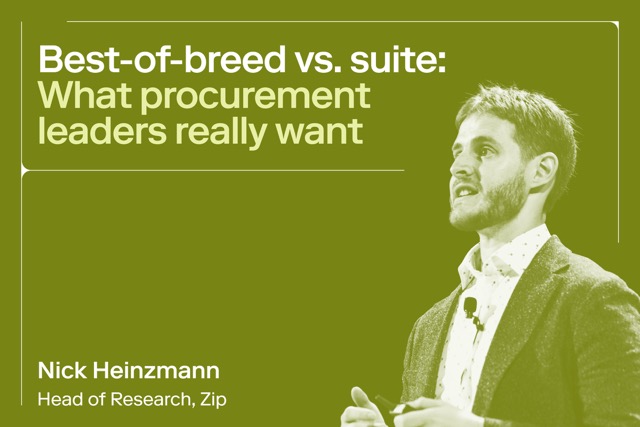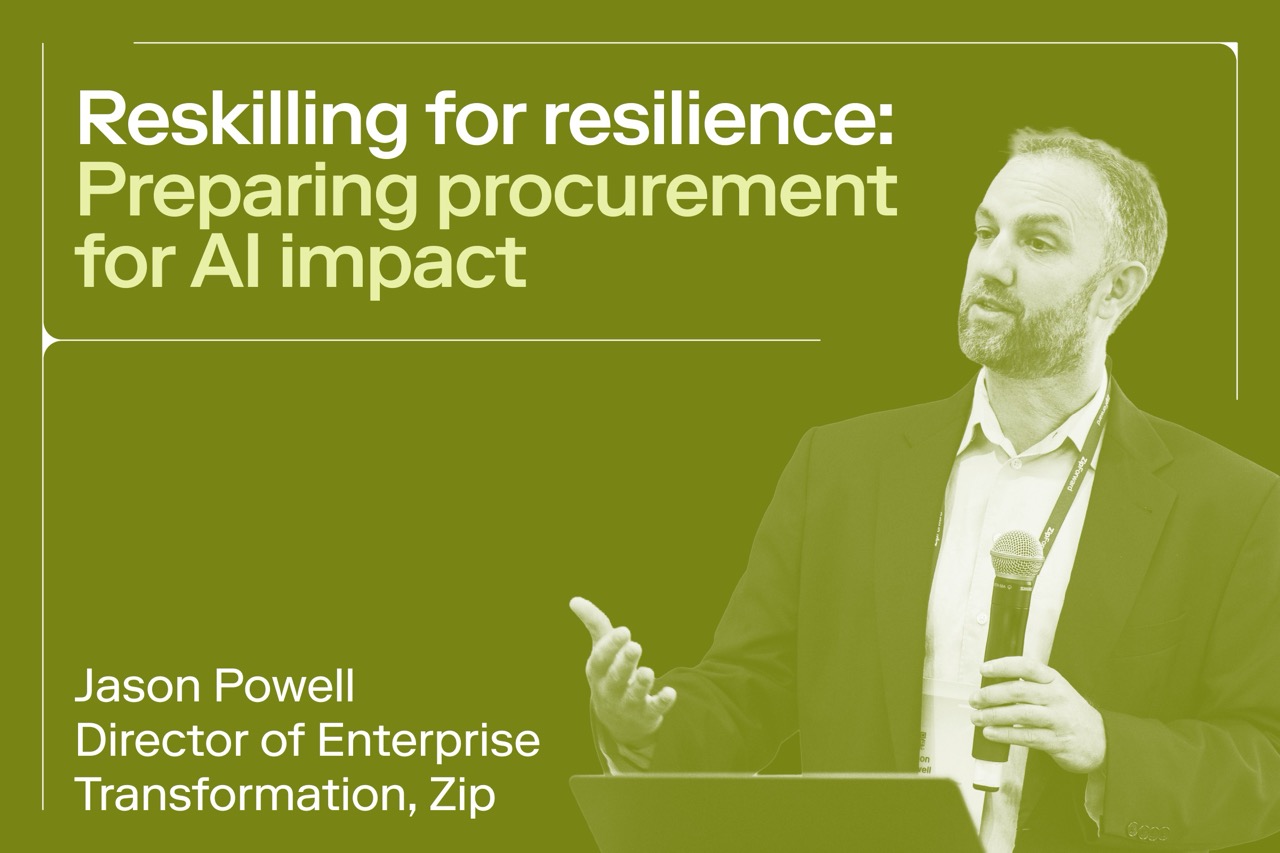
ViDA for procurement: What EMEA leaders need to know
How procurement teams across Europe can prepare for the VAT changes under ViDA.

The relentless march of digitization has fundamentally reshaped the global economy, blurring geographical boundaries and accelerating the pace of new business models. But as business moves faster, regulation is following close behind.
This is evident in the EU’s rollout of “VAT in the Digital Age” (ViDA), a sweeping set of reforms that will transform how VAT is reported, invoiced, and managed in the coming years.
For procurement leaders, this goes beyond just updating tax structures. It’s a complete risk, compliance, and systems challenge with serious operational implications.
To stay ahead, procurement and finance teams must align early, establishing unified processes, real-time visibility, and clear controls over supplier data, invoicing formats, and VAT reporting obligations across the region.
In other words: ViDA compliance flows require orchestration.
This guide will walk you through:
- What ViDA entails
- When it goes live
- Steps procurement teams can take today to prepare
We’ll also explore how intelligent intake-to-procure and modern risk orchestration strategies can help your team get, and stay, compliant as VAT rules evolve.
What is ViDA and what are its goals?
ViDA, formally known as the "VAT in the Digital Age" proposal, is a significant undertaking by the European Union to overhaul its VAT system to better suit the digital economy.
The proposal was first published by the Commission in December 2022 and has undergone extensive discussions before being politically agreed upon in November 2024. The European Parliament gave its green light to these changes in February 2025, and the EU Council formally adopted the package on 11 March 2025, marking its final approval.
ViDA formally enters into force on April 14, 2025, but its key mandates will phase in over the following years.
"Almost all businesses will be impacted in some way,” says KPMG. “In preparation for the new rules, businesses will have to make significant changes to their systems and processes, and in order to be ready to implement these in a timely manner."
With adoption complete, the European Commission is set to release Working Papers for each of ViDA’s three pillars, expected by summer 2025, with full implementation dates beginning in 2028.
The key objectives underpinning ViDA are multifaceted.
Firstly, to address the distortion of competition by ensuring VAT is paid on services provided through online platforms, a principle that already applies to similar services in the traditional economy.
Secondly, ViDA aims to combat the growing issue of VAT fraud through enhanced digitalization of reporting obligations.
Lastly, the initiative seeks to simplify the administrative burden for businesses engaged in cross-border activities.
The European Commission estimates that Member States will recoup up to €11 billion annually in lost VAT revenues over the next decade thanks to these updates.
When does ViDA come into effect?
While the full impact of ViDA will unfold over several years, procurement leaders must be aware of the key implementation milestones to plan effectively. The most important dates to mark on your calendar are:
- July 1, 2028: This date marks the expected introduction of the Platform Economy and Single VAT Registration portion of ViDA.
Specifically, by this date, online platforms will generally be required to pay VAT for services provided through them where the individual service providers do not charge VAT, particularly impacting the short-term accommodation rental and road passenger transport sectors.
- July 1, 2030: This is the most important date for the E-invoicing and Digital Reporting part of the initiative.
By this time, EU VAT registered businesses will be obliged to issue structured e-invoices for cross-border business-to-business (B2B) and business-to-government (B2G) supplies within the EU. These e-invoices will need to adhere to a standard EU format, and the data will need to be digitally reported to the relevant tax authorities, potentially rendering EC Sales Lists obsolete.
What are the three pillars of ViDA?
ViDA rests on three fundamental pillars, each with significant implications for how procurement operates within the EU:
Pillar 1: Digital Reporting Requirements (DRR) and mandatory e-invoicing
Core changes: The cornerstone of this pillar is the move towards mandatory EU e-invoicing for cross-border B2B and B2G transactions by July 1, 2030. This will require businesses to issue structured e-invoices in a standard EU format within ten days of the supply (or payment, if earlier).
Furthermore, key data from these e-invoices must be digitally reported directly to tax authorities, streamlining reporting and enhancing their ability to combat VAT fraud. This digital reporting of data will mean that periodic EC Sales Lists are no longer required.
Procurement implications: Procurement teams will need to ensure their Enterprise Resource Planning (ERP) and invoicing systems are capable of generating and processing e-invoices in the required EU format.
This may necessitate system upgrades or the adoption of new software solutions. The data required on invoices from suppliers may change, requiring adjustments to procurement processes and supplier agreements.
Procurement leaders should also stay alert to earlier domestic mandates in specific Member States, which may require compliance ahead of the EU-wide timeline.
Pillar 2: Changes to the VAT treatment for the platform economy
The "Deemed Supplier" Rule: From July 1, 2028 (potentially later in some Member States), digital platforms facilitating short-term accommodation rentals (30 consecutive nights or less) and road passenger transport will, in most cases, be considered the "deemed supplier" for VAT purposes and will be liable to account for VAT on these services.
Procurement Implications: Procurement leaders need to re-evaluate their engagement with online platforms used for services like business travel and short-term project accommodations.
The "deemed supplier" rule could lead to changes in how VAT is applied and invoiced for these services. Understanding the VAT status of suppliers operating on these platforms will become ever more important, as will the platform's approach to VAT collection and reporting.
Pillar 3: Simplified single VAT registration
Expanding the One Stop Shop (OSS): The existing OSS regime, which simplifies VAT obligations for B2C distance sales, will be extended to cover other B2C supplies, including electricity and natural gas, supply and install contracts, and certain domestic supplies of goods and services, mainly from July 1, 2028.
A significant addition for procurement is a new OSS module for businesses to report movements of their own goods between EU Member States, potentially eliminating the need for VAT registration in the country of arrival. The current VAT call-off stock simplification will become redundant and will be abolished.
Extended Reverse Charge Mechanism: The reverse charge mechanism for B2B transactions will be broadened. Member States will be obliged to allow the reverse charge if a non-established supplier is not VAT registered in the country where the VAT is due and the customer is. This aims to reduce the circumstances requiring VAT registration for non-established suppliers.
Procurement Implications: Businesses will need to consider the benefits of using these simplifications against potentially maintaining existing foreign VAT registrations.The expanded OSS may simplify VAT obligations for EU cross-border procurement, potentially reducing the need for multiple VAT registrations.
Procurement teams should assess if leveraging the expanded OSS could streamline their supply chain. However, VAT registrations in other Member States may still be required, particularly for intra-Community supplies of goods, which will be subject to new digital reporting requirements from July 1, 2030.
Businesses should weigh the benefits of using these simplifications against maintaining existing foreign VAT registrations.
The procurement leader’s roadmap to ViDA readiness
If this all sounds like a lot, it is. Given the scope and potential impact of ViDA, procurement leaders should take proactive steps to prepare their organizations:
1. Conduct a comprehensive internal assessment
Map all current procurement processes that involve cross-border transactions, engagement with online platforms (especially in accommodation and transport), and the movement of own goods within the EU.
Evaluate your existing invoicing and VAT reporting systems to determine their readiness for e-invoicing and digital reporting requirements. Identify specific areas where the Platform Economy rules may affect your sourcing strategies.
2. Foster cross-functional collaboration
Engage closely with your finance, tax, and IT departments. A coordinated approach is essential to fully understand the implications of ViDA, assess the necessary system changes, and develop a comprehensive implementation plan.
3. Prioritize technology and system upgrades
Assess the need to upgrade or implement new technologies to handle mandatory e-invoicing in the required EU format and to manage the digital reporting obligations. Ensure your systems can capture and manage all the necessary data elements that will be required on e-invoices.
4. Engage with your supplier ecosystem
Communicate proactively with your key suppliers, particularly those involved in cross-border transactions or operating on platforms relevant to the new "deemed supplier" rules. Understand their preparedness for e-invoicing and their VAT status if they operate via platforms. This dialogue will help foster a smooth transition.
5. Stay abreast of member state implementations
Recognize that while ViDA sets the overall framework, individual Member States may adopt certain measures earlier (like domestic e-invoicing) or have specific interpretations of the rules. Monitor updates and guidance from tax authorities in the regions where your organization and key suppliers operate.
6. Embrace the opportunity for efficiency
View ViDA not just as a compliance burden, but as an opportunity to streamline procurement processes, improve data accuracy in invoicing and reporting, and potentially reduce administrative overhead associated with cross-border VAT management.
Get ahead of regulatory change with smarter procurement processes
ViDA is a huge step change, much more than a simple update to the VAT code. It’s a wake-up call for organizations with legacy systems and siloed data. Procurement leaders must evolve to manage increasing compliance complexity, shifting VAT obligations, and supplier risk—all without slowing down business.
Zip was designed for ViDA compliance. Our intake and procurement orchestration platform helps you centralize supplier engagement, standardize e-invoicing requirements, and orchestrate controls across procurement, finance, and IT.
With our new Risk Orchestration capabilities, your team can go beyond onboarding checks, ensuring real-time visibility into supplier compliance, proactively managing regulatory changes like ViDA, and accelerating approvals with confidence.
To learn more about how Zip can help ensure procurement transparency and global compliance, be sure to schedule a demo with our expert team.
Because when compliance flows, business flows.

Maximize the ROI of your business spend

Enter your business email to keep reading
















%20Large.jpeg)





.webp)


















